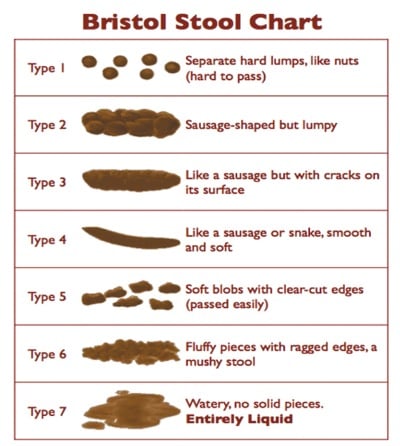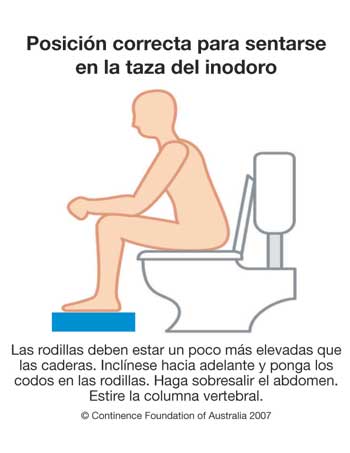|
This fact sheet explains what constipation is and suggests some ideas for improvement and tells you where to get more help. |
Esta hoja informativa explica qué es el estreñimiento y sugiere algunas ideas para su mejora e indica dónde obtener más ayuda. |
What is constipation?Constipation is a common disorder where bowel actions ('poo' or faeces) are not easily and/or less frequently passed. Symptoms of constipation include:
|
¿Qué es el estreñimiento?El estreñimiento es un trastorno común en que las acciones intestinales (“caca” o heces) se evacuan con dificultad y/o con menos frecuencia. Los síntomas del estreñimiento incluyen:
|
What does being 'Regular' mean?
|
¿Qué significa ser “regular”?
|
What can cause constipation?
|
¿Qué puede causar el estreñimiento?
|
What should your 'poo' look like?Your poo should be light or dark brown, sausage-shaped, soft but firm, easy to pass and with minimal odour. Aim to have a type 3 or type 4 bowel action.  |
¿Cómo debe ser su “caca”?Su caca debe ser de color marrón claro u oscuro, en forma de salchicha, suave pero firme, fácil de pasar y con mínimo olor. Trate de lograr una acción del intestino tipo 3 o tipo 4.  |
Common Bowel ProblemsFaecal Impaction - When constipation causes faeces to pack the intestine (digestive tract) so tightly that your normal pushing action in the toilet is not strong enough to push the faeces out. Faecal Incontinence (sometimes referred to as 'soiling') - This is the accidental loss of liquid or solid faeces. This can be due to the bowel (which stores the faeces) being too full, but this may be only one of the causes. Uncontrolled flatus ('wind') is often considered evidence of faecal incontinence. Haemorrhoids (sometimes referred to as 'piles') - This can be the result of straining to have a bowel movement. This strain (similar to heavy lifting) can damage the rectum's veins. This can cause bleeding, soreness and itching. Rectal Prolapse - This occurs when long-term straining causes a small amount of bowel lining to push out from the anus, which is a ring of muscle that opens and closes when we pass a bowel motion. |
Problemas Comunes del IntestinoRetención fecal – Ocurre cuando el estreñimiento hace que las heces empaqueten el intestino (tracto digestivo) con tanta fuerza que su acción de empuje normal en el inodoro no es lo suficientemente fuerte como para empujar las heces hacia fuera. Incontinencia fecal (algunas veces referido como “ensuciarse”) - Esta es la pérdida accidental de heces líquidas o sólidas. Esto puede ser debido a que el intestino (que almacena las heces) esté demasiado lleno, pero ésta puede ser sólo una de las causas. Los flatos descontrolados ("vientos"), a menudo se consideran como evidencia de incontinencia fecal. Hemorroides (a veces referido como "almorranas") - Esto puede ser resultado del esfuerzo realizado para efectuar una evacuación intestinal. Este esfuerzo (similar a levantar objetos pesados), puede dañar las venas del recto. Esto puede causar sangrado, dolor y picazón. Prolapso Rectal - Esto ocurre cuando un esfuerzo a largo plazo causa que una pequeña porción del revestimiento intestinal salga del ano, el cual es un anillo de músculo que se abre y se cierra cuando se pasa un movimiento intestinal. |
How constipation affects bladder controlConstipation can cause accidential leakage from your bladder. An overfull bowel will cut down the volume of urine your bladder can hold and you will feel the need to go to the toilet often and in a hurry.  |
Cómo el estreñimiento afecta el control de la vejigaEl estreñimiento puede causar una fuga accidental de la vejiga. Un intestino sobrelleno reduce el volumen de orina que puede contener la vejiga y usted sentirá la necesidad de ir al baño con frecuencia y con prisa.  |
Here are five ways to keep your bladder and bowel healthy and prevent constipation:Eat well to keep your bowels regular and to have a healthy body weight Eat a healthy diet high in fibre (at least 30g per day). Drink well to prevent constipation and bladder irritation Drink 1.5 -2 Litres(6-8 glasses) of fluid each day unless advised otherwise by your doctor. Fluid is water, fruit juice, tea, coffee, milk, soup, jellies and icecream. Exercise daily to prevent constipation and keep a healthy body weight Keep your pelvic floor strong for good bladder and bowel control Request a pelvic floor muscle exercise leaflet by calling the National Continence Helpline 1800 33 00 66. Toileting habits - Go to the toilet as soon as you need to and empty your bowel fully. Remember to relax. |
He aquí cinco maneras de mantener la vejiga y el intestino sanos y evitar el estreñimiento:Comer bien para mantener las funciones intestinales regulares y mantener un peso corporal saludable Consumir una dieta rica en fibra (por lo menos 30 g por día). Beber bien para evitar el estreñimiento y la irritación de la vejiga. Beber de 1,5 a 2 litros (6-8 vasos) de líquido cada día, salvo indicación contraria de su médico. El agua, el jugo de frutas, el té, el café, la leche, la sopa, las jaleas y los helados se consideran como fluiídos líquidos. Hacer diariamente ejercício para evitar el estreñimiento y mantener un peso corporal saludable. Mantener el piso pélvico fuerte para el buen control de vejiga y los intestinos. Solicitar un folleto sobre ejercicios de los músculos del piso pélvico llamando a la “Línea de Ayuda Nacional de Continencia” al 1800 33 00 66. Hábitos de ir al inodoro - Ir al inodoro tan pronto como lo necesite y vacíe el intestino completamente. Recuerde que debe relajarse. |
|
Check your toileting postion:
 |
Revise la posición en el inodoro:
 |
Laxatives
|
Laxantes
|
|
There are three types of laxatives:
|
Hay tres tipos de laxantes:
|
|
If constipation is severe or continuing, go to your Doctor. |
Si el estreñimiento es severo o contínuo, visite al doctor. |
Who can help?The first step to improving your bowel control is to have a full continence assessment carried out by a health professional. |
¿Quién puede ayudar?El primer paso para mejorar el control de los intestinos es someterse a una evaluación completa de continencia llevada a cabo por un profesional de la salud. |
For more informationThere are a range of health professionals who can help you deal with constipation.
|
Mayor informaciónHay varios profesionales de la salud que pueden ayudarle a combatir el estreñimiento.
|
Constipation and Bowel Control in Spanish
El Estreñimiento y el Control Intestinal
Last Updated: Fri 30, Jul 2021
Last Reviewed: Tue 17, Mar 2020

